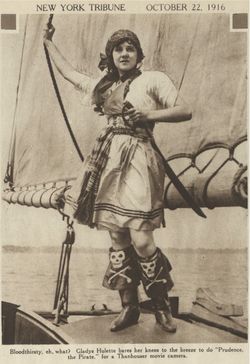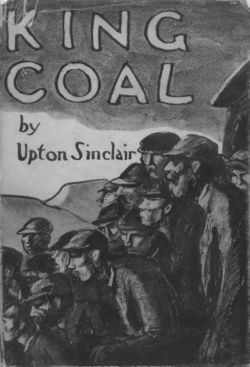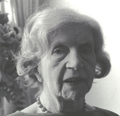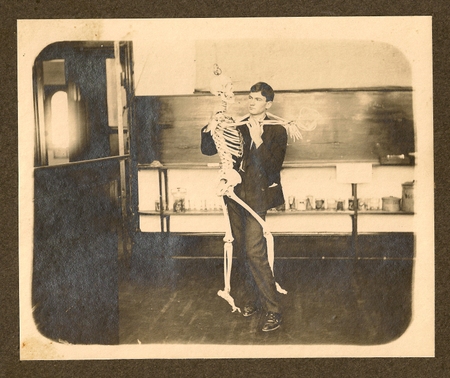"Bootylicious," my review of Peter T. Leeson's The Invisible Hook, appears in the 7 September 2009 issue of the New Yorker.
As in the past, I'd like to offer on this blog some description of the sources that were useful to me in writing the article. The customary caveat: this post won't make much sense if you haven't yet read the article in question first. My first thanks, as usual, are for the book under review, Leeson's Invisible Hook, which is dapper and brisk besides being very well researched.
The best descriptions of pirates come from people taken captive by them. Captain William Snelgrave, whom I use to start my article, tells his story in A New Account of Some Parts of Guinea, and the Slave-Trade, which, though published in 1734, is mysteriously unavailable in Google Books. The only physical copy I can find for sale is a 1971 reprint—for $430. Talk about piracy! Within the scholarly world, Snelgrave's narrative is also famous for his observations of Africa and of slave-trading, which he defends. Another captive, Captain George Roberts, describes having been seized near the Cape Verde Islands in 1722 in The Four Years' Voyages of Capt. George Roberts. "You Dog! You Son of a Bitch! you Speckled-Shirt Dog!" one of his captors curses him. Asked who he thinks his captors are, Roberts submissively answers that "I believed they were Gentlemen of Fortune belonging to the Sea," only to be told off once more: "You lie by God, we are Pirates, by God." Roberts tells a good yarn, so good that some have wondered whether it might be fiction, but I think it's too good for that. When, for example, one of the pirates maroons Roberts on the high seas in a boat with no sail and no provisions, the pirate bestows on Roberts, in parting, a musket with a small amount of powder, calling it a special gift. The gift puzzles Roberts. In fact, though Roberts never figures it out, a loaded gun was traditionally given by one pirate to another when he marooned him—so the marooned man could shoot himself instead of starving to death slowly. It would take a subtle novelist to resist writing the scene where it dawns on Roberts what the musket is for; it seems more likely to me that Roberts's experience and ignorance were both genuine.
Two more captives tell their stories in the General History of the Pyrates, a book I'll describe in a moment. One of them, Captain Evans of the Greyhound, is quoted in my article saying he prefers to keep his hand and lose his gold. At the moment when another captive, Captain Macrae, is afraid that he's going to lose his life, "a Fellow with a terrible Pair of Whiskers, and a wooden leg, being stuck round with Pistols, like the Man in the Almanack with Darts, comes swearing and vapouring upon the Quarter-Deck." To Macrae's surprise, the blustering fellow acclaims him "an honest Fellow," and the testimony saves him. (After reading this story, I wasted a fair amount of time trying to figure out who "the Man in the Almanack with Darts" was, and here's the answer, courtesy of Notes and Queries, 13 June 1908: "The reference . . . is evidently an allusion to the woodcuts in the ephemerides of the seventeenth and eighteenth centuries illustrating the supposed effects of the planets, &c., on the diseases in various parts of man's body. . . . The arrows are merely lines pointing to the head, heart, breast, legs, feet, &c., of a small naked figure."
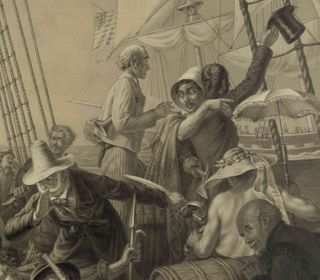 Several buccaneers left narratives. The most famous is The Buccaneers of America (first English edition, 1684) by A. O. Exquemelin, a Frenchman who served with Henry Morgan and later became a surgeon in Holland. Exquemelin has some nice observations of life in the New World—flamingo meat and crocodile eggs are very tasty, he reports, and one of the few drawbacks of Caribbean life are these insects known as mosquitoes ("most vexing of all is the noise they make in one's ears")—but there's so much torture in his story that it's quite grim and grisly. I read Alexis Brown's translation, but there's an older translation available for download on Google Books. The Library of Congress offers an online display of the illustrations to the 1678 Dutch edition. Another buccaneer, Basil Ringrose, wrote an account of further depredations that picks up where Exquemelin left off, and it has often been reprinted as the second half of Exquemelin's book.
Several buccaneers left narratives. The most famous is The Buccaneers of America (first English edition, 1684) by A. O. Exquemelin, a Frenchman who served with Henry Morgan and later became a surgeon in Holland. Exquemelin has some nice observations of life in the New World—flamingo meat and crocodile eggs are very tasty, he reports, and one of the few drawbacks of Caribbean life are these insects known as mosquitoes ("most vexing of all is the noise they make in one's ears")—but there's so much torture in his story that it's quite grim and grisly. I read Alexis Brown's translation, but there's an older translation available for download on Google Books. The Library of Congress offers an online display of the illustrations to the 1678 Dutch edition. Another buccaneer, Basil Ringrose, wrote an account of further depredations that picks up where Exquemelin left off, and it has often been reprinted as the second half of Exquemelin's book.
Pirates (as opposed to buccaneers) left few first-hand documents. The General History reprints a few fragments from what it claims was Blackbeard's diary: "rum all out:—our Company somewhat sober:—A damn’d Confusion amongst us!" And there is the occasional threatening letter, such as the one from Henry Every that I quote, which is reprinted in J. Franklin Jameson, Privateering and Piracy in the Colonial Period (1923), a collection of letters, reports, and legal documents, glossed with very helpful footnotes. There is also the testimony that pirates gave in court, the amplest source of which may be the four volumes (well, two of the four volumes) of Joel H. Baer's British Piracy in the Golden Age.
And then there's Charles Johnson's A General History of the Pyrates (1724), which is droll and vivid. You want the version edited by Manuel Schonhorn, because it's the most meticulous, even though Schonhorn thought that "Charles Johnson" was a pseudonym for Daniel Defoe. In fact, Arne Bialuschewski has shown that it was almost certainly a pseudonym for the journalist Nathaniel Mist.
Between them, Exquemelin's Buccaneers and Johnson/Mist's General History are the source of almost all the great stories about pirates. Given the standards of historiography of their era, they're considered to be remarkably accurate. Still, they do contain instances of embroidery, including, in the case of Johnson/Mist, a long Voltairean (in style though maybe not spirit, depending on the level of irony you choose to read it at) fantasy about a pirate utopia in Madagascar called "Libertalia." Another problem: Johnson/Mist's book is a jumble, chronologically speaking. Only modern history will help you sort wheat from chaff. C. R. Pennell has written an excellent bibliographic essay about pirate scholarship, which appears at the start of his collection Bandits at Sea: A Pirates Reader, which itself contains a broad sample of historical essays, including several on pirates other than the English-speaking ones. To speak very generally, pirate history comes in two sorts: those that describe piracy as a system, and those that describe it as a series of events. (I'm speaking crudely, of course; all do both, to some extent.) Leeson's book falls into the first category, as do such works as Christopher Hill's essay "Radical Pirates?" (1984) and Marcus Rediker's wonderful Villains of All Nations: Atlantic Pirates in the Golden Age. (Rediker's pioneering effort on pirates was a chapter in his Between the Devil and the Deep Blue Sea: Merchant Seamen, Pirates and the Anglo-American Maritime World, 1700 – 1750.) Villains of All Nations is lively and astute, and in many ways Rediker's Marxian analysis of pirates anticipates Leeson's. Rediker also seems to have read every pirate-related document ever created. Somewhat lighter in spirit, but also very responsible, is David Cordingly's Under the Black Flag: The Romance and the Reality of Life Among the Pirates, which overlays pirate sociology with a tour of the literature and film created out of pirate lore in later centuries.
As for books that offer a more narrative history of pirates, English-speaking pirates did so much dastardy that it's hard to fit the whole story between two covers. One book that manages to tell the full tale is Patrick Pringle's Jolly Roger: The Story of the Great Age of Piracy (Norton, 1953), which covers it all—Elizabethan privateers, colonial-era buccaneers, and Enlightenment-age pirates. Pringle was a sedulous researcher, but new facts have come to light in the half-century since he wrote, so he can't always be relied on as a final authority. His felicitous style more than compensates, though; he's something of a wit. On the matter of pirate governance, he, too, anticipates Leeson's arguments:
Those seamen, mostly illiterate and uneducated, freed from moral and legal restraints, would to-day be regarded as unfit for self-government. . . . Where discipline is removed, self-discipline emerges in the most unlikely places. . . . It worked. Anarchism on a small scale usually does, if it is left in peace. Anarchism on a large scale has not yet been tried.
For in-depth and fully end-noted history, three relatively recent accounts are as riveting as adventure tales: Peter Earle's The Sack of Panamá: Captain Morgan and the Battle for the Caribbean (1981) describes the buccaneer Henry Morgan's opportunistic but (in English eyes) legal raids on Spanish territories in the 1660s and 1670s; Robert C. Ritchie's Captain Kidd and the War against the Pirates (1986) lucidly narrates Kidd's late-seventeenth-century plundering against a background of political intrigue between Whigs and Tories; and Colin Woodard's The Republic of Pirates: Being the True and Surprising Story of the Caribbean Pirates and the Man Who Brought Them Down (2007) tells the story of the last generation of Golden Age pirates, those of the early eighteenth century, including Blackbeard, Charles Vane, and Samuel Bellamy, and the role played in their demise by Bahamas governor Woodes Rogers.
A note on pirate sex: B. R. Burg argued in Sodomy and the Pirate Tradition (1983) that pirates practiced homosexuality more freely than their contemporaries. The circumstances do suggest that this might be likely, as do Bartholomew Roberts's pirate articles, which forbade the presence of any "boy or woman" on board. I'm reluctant to rule it out, knowing what one knows about the British Navy, the original employer of most pirates, and about the propensity of modern-day historians to sweep such matters under the rug. (In Under the Black Flag, for instance, Cordingly quotes Roberts's articles, including the diktat against "boy or woman," and then writes, "There is no mention in this code . . . of homosexuality." Argh, as the pirates say.) But there's not enough evidence to make any positive assertion. The ultimate source of a number of supposed accounts of pirate homosexuality is Louis Le Golif's Memoirs of a Buccaneer, widely suspected of being a twentieth-century fiction. When Le Golif's tales are excluded, very little evidence of pirate sodomy remains. Ringrose's narrative is the source of the anecdote in my article of the servant who claims to have been buggered by his buccaneer master. (Confusingly, the relevant passage does not appear in the reprint linked to above, but only in the original 1685 edition.) The servant confesses, however, just as his master is losing a power struggle with other buccaneers, so his confession might be true, might be part of a smear campaign, or might be both, but in any case it isn't a happy moment of love and liberation. Also intriguing is the testimony given in a court case involving a pirate named Powell, who told a sailor, "I wish you and I were both ashore here stark naked." Rediker reports the line as possibly containing an erotic charge, but when read in its original context (the line appears at vol. 3, page 186 of Baer's British Piracy in the Golden Age), it seems more likely that the statement was recalled in court as evidence of the extremity of Powell's wish to be off the pirate ship, not as evidence of sexual interest.
Pirates, you will not be surprised to hear, are all over the internet. In conclusion, as a representative sampling, here are American soldiers flying Jolly Roger in Afghanistan, a Victorian toy theater for rehearsing the adventures of Blackbeard in your pinafore at home, and an early episode of the exceedingly goofy "Auto-Tune the News" featuring both pirates and gay marriage.

